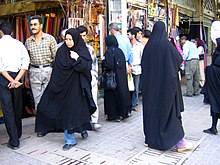Chador


A chador (in Persian: چادر, romanized: châdor) is a typically Iranian female street garment, consisting of a simple semicircular piece of cloth open at the front that is placed on the head, covering the entire body. except the face.
The most common color of chadors today is black, although others are also observed, particularly in rural areas, among Zoroastrians and in places of pilgrimage or domestic environments, where light colors are common with flower prints.
The chador, which dates back in its current form to at least the XVIII century, became widespread in Iran as a street garment. common during the Qajar dynasty (1794-1925). Monarch Reza Shah banned it in 1936 within the framework of his general policy of forced Westernization of the country. The ban was relaxed under the reign of his son, Shah Mohammad Reza Pahlavi. At the end of the 1970s, the Iranian revolution saw in the chador, indigenous and in accordance with the Islamic dress code (hijab), a sign of national identity and an instrument for safeguarding national and religious identity against Westernization and, thus, The Islamic Republic of Iran promotes the use of the chador and in certain areas (state buildings, mosques or places of pilgrimage) imposes it.